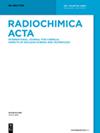将电泳薄硼沉积物用作中子探测器
IF 1.7
3区 化学
Q4 CHEMISTRY, INORGANIC & NUCLEAR
引用次数: 0
摘要
检测核辐射是一项独特的挑战,尤其是中子这种中性粒子。直接探测的方法需要利用一种转换材料作为中介。硼在这一过程中起着关键作用,它与热中子反应生成α粒子和锂,在 10B (n,α) 7Li 反应中释放出 2.314 MeV 的显著能量。这有助于在辐射探测系统中有效识别和测量中子。粒子 α(E = 1.474 MeV)和 Li(E Li = 0.842 MeV)的运动轨迹。核探测器的活性介质(通常是气体)会被这些高电荷粒子电离,或形成离子对,然后被电极收集,在探测器的输出端产生信号。有多种沉积方法可用于此目的,其中电泳在简便性和精确性方面具有明显优势。本研究详细介绍了利用电泳技术在我们实验室开发的原型探测器管壁上沉积硼的情况。本文章由计算机程序翻译,如有差异,请以英文原文为准。
Application of thin boron deposit by electrophoresis as neutron detectors
Detecting nuclear radiation presents a distinctive challenge, particularly with neutrons, which are neutral particles. The method of direct detection involves the utilization of a converter material, acting as an intermediary. Boron plays a pivotal role in this process, reacting with thermal neutrons to generate alpha particles and lithium, with a notable energy release of 2.314 MeV during the 10 B (n,α) 7 Li reaction. This facilitates effective identification and measurement of neutrons in radiation detection systems. The paths of the particles α (for E = 1.474 MeV) and Li (for E Li = 0.842 MeV). The active medium of the nuclear detector, typically a gas, undergoes ionization by these highly charged particles, or they form ion pairs that are subsequently collected by electrodes to produce the signal at the detector’s output. Various deposit methods can be used for this purpose, electrophoresis offers a distinct advantage in terms of both simplicity and precision. This study details the utilization of the electrophoresis technique for the deposition of boron on the tube walls of prototype detectors developed within our laboratory.
求助全文
通过发布文献求助,成功后即可免费获取论文全文。
去求助
来源期刊

Radiochimica Acta
化学-核科学技术
CiteScore
2.90
自引率
16.70%
发文量
78
审稿时长
6 months
期刊介绍:
Radiochimica Acta publishes manuscripts encompassing chemical aspects of nuclear science and technology.
 求助内容:
求助内容: 应助结果提醒方式:
应助结果提醒方式:


